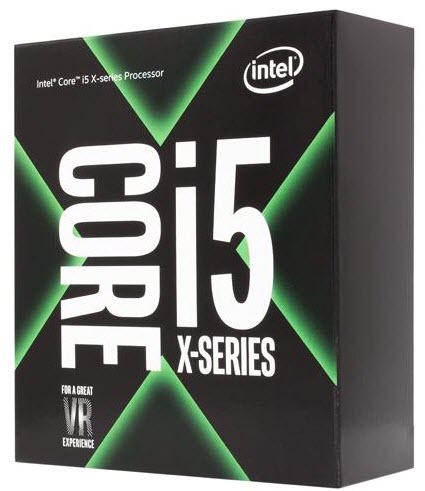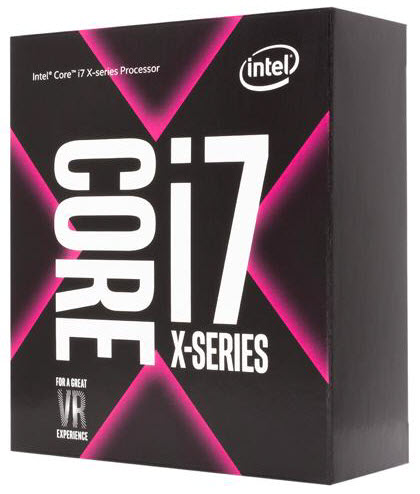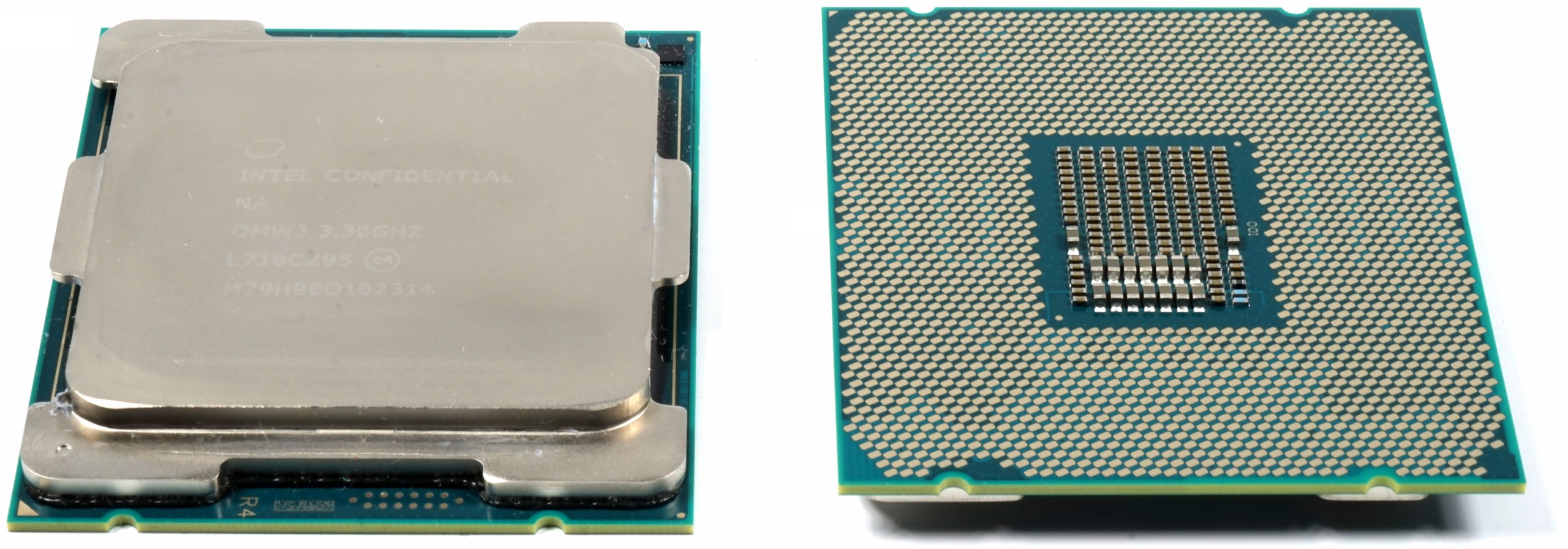Early Verdict
Intel’s Skylake-X-based Core i9-7900X weighs in with 10 Hyper-Threaded cores and architectural enhancements that benefit many workstation-class workloads, such as rendering and content creation. But the processor struggles in some games compared to its predecessor, failing to match the Core i7-6950X in several titles.
Pros
- +
Great performance in workstation and productivity applications
Cons
- -
Performance regresses in some games compared to prior generation
- -
High price
- -
Poor thermal performance
Why you can trust Tom's Hardware
Introduction
Intel’s new Skylake-X processors span the Core i7 and i9 families, but all drop into the same LGA 2066 interface, enabled by the X299 chipset. They're aimed specifically at high-end desktop users who need anywhere from four to 18 physical cores. Meanwhile, existing Skylake-S processors soldier on, popping into LGA 1151-equipped motherboards for mainstream desktops.
The company claims that several architectural enhancements to Skylake-X provide as much as 15% more performance than Broadwell-E in single-threaded workloads, while heavily-threaded tasks should be up to 10% faster.
Dominance in the high-end desktop segment began a decade ago for Intel. Since then, the CPU market has largely been a lopsided affair. Without much competition challenging its position, Intel never saw fit to cut prices or innovate aggressively. AMD's return to the table with Ryzen changed that with more cores, SMT, and unlocked multipliers, all for less money.
Now Intel is looking to defend its flagship against the recently-announced AMD Threadripper CPU, sporting 16 cores, 32 threads, and 64 lanes of third-gen PCIe connectivity. Of course, the enhancements to Skylake-X aren't any sort of knee-jerk reaction. These were in the works for years. Still, Intel moved on today's announcement with unfamiliar speed (tripping on its laces in the process). It also adjusted pricing in a way we haven't seen before. Enthusiasts, enjoy.
Specifications
The 12+ core Skylake-X models are still on the distant horizon, and our Core i7-7440X was inexplicably delayed in shipping. That leaves us with the 10-core Core i9-7900X for today's review. But first, let's discuss the complete line-up of high-end options:
Kaby Lake-X
We aren't accustomed to seeing current-gen architecture in the HEDT portfolio. Typically, the top models lag the mainstream chips by a generation or two. Dropping a pair of Kaby Lake-based chips into LGA 2066 changes this. Fortunately for fans of familiarity, everything else complementing the X299 platform controller hub is Skylake-based...though that could change soon. Earlier this year, Intel announced its 'Data Center First' strategy, which will see the newest processes coming to Xeon products before the desktop. Considering that the HEDT line-up consists of re-purposed data center dies, HEDT may become leading-edge.
In an unprecedented expansion, Intel grows its HEDT family from four models to nine, including those two Kaby Lake-X models. They're a curious addition, supporting two DDR4 memory channels, whereas Skylake-X exposes four. That means you can only use half of your motherboard's DIMM slots with a Kaby Lake-X CPU installed. Fewer PCIe lanes also result in restricted I/O options. Intel disables the on-die HD Graphics 630 engine, allowing the unused silicon to absorb heat and purportedly improve overclocking headroom. Aside from slightly higher base clock rates and a higher 112W TDP, the Core i5-7640X and i7-7740X are otherwise similar to their Skylake-S counterparts, right down to pricing.
Get Tom's Hardware's best news and in-depth reviews, straight to your inbox.
In our opinion, matching "affordable" processors with expensive motherboards evokes images of the Core i3-7350K, which isn't popular due to the same sort of imbalance. Intel tells us that motherboard manufacturers can build low-cost X299 platforms specifically for Kaby Lake-X, but we don't see any of them scrambling to create such a niche product as of yet.



Skylake-X
Intel supports DDR4-2666 on every Skylake-X CPU except Core i7-7800X, up from Broadwell-E's official DDR4-2400 specification. It deliberately disables ECC in order to dissuade the Xeon crowd from adopting more enthusiast-oriented platforms.
Intel hasn't released detailed specifications for the higher-end CPUs, but we expect it'll expose similar memory specifications. We also expect frequencies to decline as core counts increase.
| Active Cores | 1 | 2 | 3 | 4 | Cores 5-10 |
| Intel Core i9-7900X (GHz) Turbo Boost | 4.3 | 4.3 | 4.1 | 4.1 | 4.0 |
The Core i9-7900X features the same Turbo Boost 2.0 technology enabled on previous-generation processors, except that clock rates are notably higher this time around. Expect 4 GHz with 10 active cores. Intel also arms six of the Skylake-X models with Turbo Boost Max 3.0. The company improved this technology to target the two fastest cores running lightly threaded workloads. In Broadwell-E, Turbo Boost Max 3.0 only accelerated a single core. Both favored cores max out at 4.5 GHz. Naturally, IPC throughput should be up quite a bit, addressing the big disadvantage Intel's big HEDT chips sometimes suffered compared to its nimbler quad-core desktop SKUs. Currently, Turbo Boost Max 3.0 requires a driver on some motherboards. But Intel plans native Windows 10 support to eliminate this in the future.
We also get partial AVX-512 support, meaning the upcoming 18-core flagship should be the first desktop host processor enabling 1 TFLOPS+ of compute performance.
Skylake-X is notably different from Skylake-S in that its cache hierarchy is completely re-worked. Core i9-7900X sports more L2 and less L3, which should improve performance in most applications. A new 2D mesh architecture makes its debut as well. Like AMD's Infinity Fabric, this architectural element isn't a universal win, we're finding (more on this shortly).
Whereas enthusiasts were dismayed to discover that the 10-core Core i7-6950X would sell for $1700+, they should be happy to learn of the 10-core Core i9-7900X's $1000 price tag. Paying a cool grand is the only way to get 44 lanes of PCIe 3.0; stepping down to Core i7-7820X drops you to 28 lanes. As storage migrates to the PCIe bus, those extra lanes could come in useful for SSDs since multi-GPU configurations aren't as popular these days. Intel does expose a new PCIe Virtual RAID on CPU (VROC) feature that allows you to coalesce up to 20 SSDs into a single bootable volume. Notably, you can assemble the RAID array on any available PCIe slot, whereas previous RSTe RAID implementations required a connection to the chipset. Sidestepping the chipset circumvents the bottleneck presented by DMI. This comes at a price, unfortunately. You're forced to purchase an upgrade key that plugs into the motherboard to unlock VROC functionality. Server customers are familiar with this practice, but it's not going to be popular among enthusiasts. We don't even know what the key will cost yet.
Intel does reinstate DMI and PCIe bus overclocking, which should please power users. A new memory controller-PLL trim voltage setting is designed to increase ratio-based memory overclocking capabilities, while a new AVX-512 ratio offset joins the standard AVX offset to control thermals during taxing AVX-enabled workloads.
We encountered a few odd performance anomalies as we tested Core i9-7900X during the past week. This launch certainly feels rushed, and though motherboard firmware updates (from multiple vendors) addressed some of the oddities, others persist. It appears that Intel's Skylake-X models will require a period of optimization, much like AMD's Ryzen processors. Let's take a look at the factors affecting Skylake-X's performance.
MORE: Best CPUs
MORE: Intel & AMD Processor Benchmark Hierarchy
MORE: All CPU Content

Paul Alcorn is the Editor-in-Chief for Tom's Hardware US. He also writes news and reviews on CPUs, storage, and enterprise hardware.
-
Pros: 10/20 cost now $999Reply
Cons: Everything else
My biggest problem with this Intel lineup is that if you want 44 PCIe you have to pay $999. No, thanks. My money goes to AMD ThreadRipper.
Good review! -
rantoc Doubt many who purchase such high end cpu for gaming runs at a low full hd 1080p resolution, i know its more cpu taxing to run lower res at higher fps but that's for the sake of benchmarking the cpu itself.Reply
I would like to see 1440p + 2160p resolutions on a suitable high end card (1080ti or equalent) benchmarked with the cpu as well as it would represent real scenarios for the peeps considering such cpu.
Thanks for a good review! -
James Mason So it seems like de-lidding the x299 processors is gonna be a standard thing now to replace the TIM?Reply -
elbert Meet netburst 2.0 that not only can hit 100c at only (4.7Ghz)1.2v on good water cooler but only barely beats a 7700k not overclocked in games. All this is yours for the low low price of 3X. Its slower than the old 6950x in a few tests with was odd.Reply -
James Mason Reply
The differences would be less noticeable at higher res than 1080p, so.... you'd just see less dissimilar numbers.19835717 said:Doubt many who purchase such high end cpu for gaming runs at a low full hd 1080p resolution, i know its more cpu taxing to run lower res at higher fps but that's for the sake of benchmarking the cpu itself.
I would like to see 1440p + 2160p resolutions on a suitable high end card (1080ti or equalent) benchmarked with the cpu as well as it would represent real scenarios for the peeps considering such cpu.
Thanks for a good review! -
Dawg__Cester Hmmmmm. I bought a Ryzen 1700, a water cooler, Asrock B350 MB, 16gb ram 3200Mhz for $590 plus tax. I live in New Jersey. I was very nervous about making the purchase as I knew this was coming out this week but the sale prices got me. Unless you all think I got ripped off, (DON'T TELL ME). But in all honesty I have not regretted the purchase one bit!! I even managed to save enough to get a GTX 1080 FE GPU. I did have a few bumps in the road getting the system stable (about 3 hours configuring after assembly) but I am VERY happy. I used Intel primarily and never really considered AMD other than for Video adapters and SSDs.Reply
After reading this along with other articles and YT videos, I have no regerts as I enjoy my Milky Way and play my games among other things.
Just my experience. I am not seeking positive reinforcement nor advice.
I just feel very satisfied that I did not wait and cough up 3oo more fore something I could have for less. I know, I know it makes no sense.
But come on fellas, its the computer game!! -
James Mason Reply19835862 said:Hmmmmm. I bought a Ryzen 1700, a water cooler, Asrock B350 MB, 16gb ram 3200Mhz for $590 plus tax. I live in New Jersey. I was very nervous about making the purchase as I knew this was coming out this week but the sale prices got me. Unless you all think I got ripped off, (DON'T TELL ME). But in all honesty I have not regretted the purchase one bit!! I even managed to save enough to get a GTX 1080 FE GPU. I did have a few bumps in the road getting the system stable (about 3 hours configuring after assembly) but I am VERY happy. I used Intel primarily and never really considered AMD other than for Video adapters and SSDs.
After reading this along with other articles and YT videos, I have no regerts as I enjoy my Milky Way and play my games among other things.
Just my experience. I am not seeking positive reinforcement nor advice.
I just feel very satisfied that I did not wait and cough up 3oo more fore something I could have for less. I know, I know it makes no sense.
But come on fellas, its the computer game!!
PCPartPicker part list / Price breakdown by merchant
CPU: AMD - Ryzen 7 1700 3.0GHz 8-Core Processor ($299.39 @ SuperBiiz)
Motherboard: ASRock - AB350M Micro ATX AM4 Motherboard ($65.98 @ Newegg)
Memory: G.Skill - Ripjaws V Series 16GB (2 x 8GB) DDR4-3200 Memory ($124.99 @ Newegg)
Total: $490.36
Prices include shipping, taxes, and discounts when availableGenerated by PCPartPicker 2017-06-19 10:47 EDT-0400
Depends on which watercooler and which ram, but not really. -
Jakko_ Wow, compared to the Ryzen 1800X, the Intel Core i9-7900X:Reply
is about 25-30% faster
costs 105% more
uses 35-40% more power
Ryzen looks really good here, and together with the temperature problems, Intel seems to be in some deep shit. -
HardwareExtreme Too little, too late. Does Intel really think that just because it has "Intel" written on it that it must be worth $200-$300 than AMD?Reply
